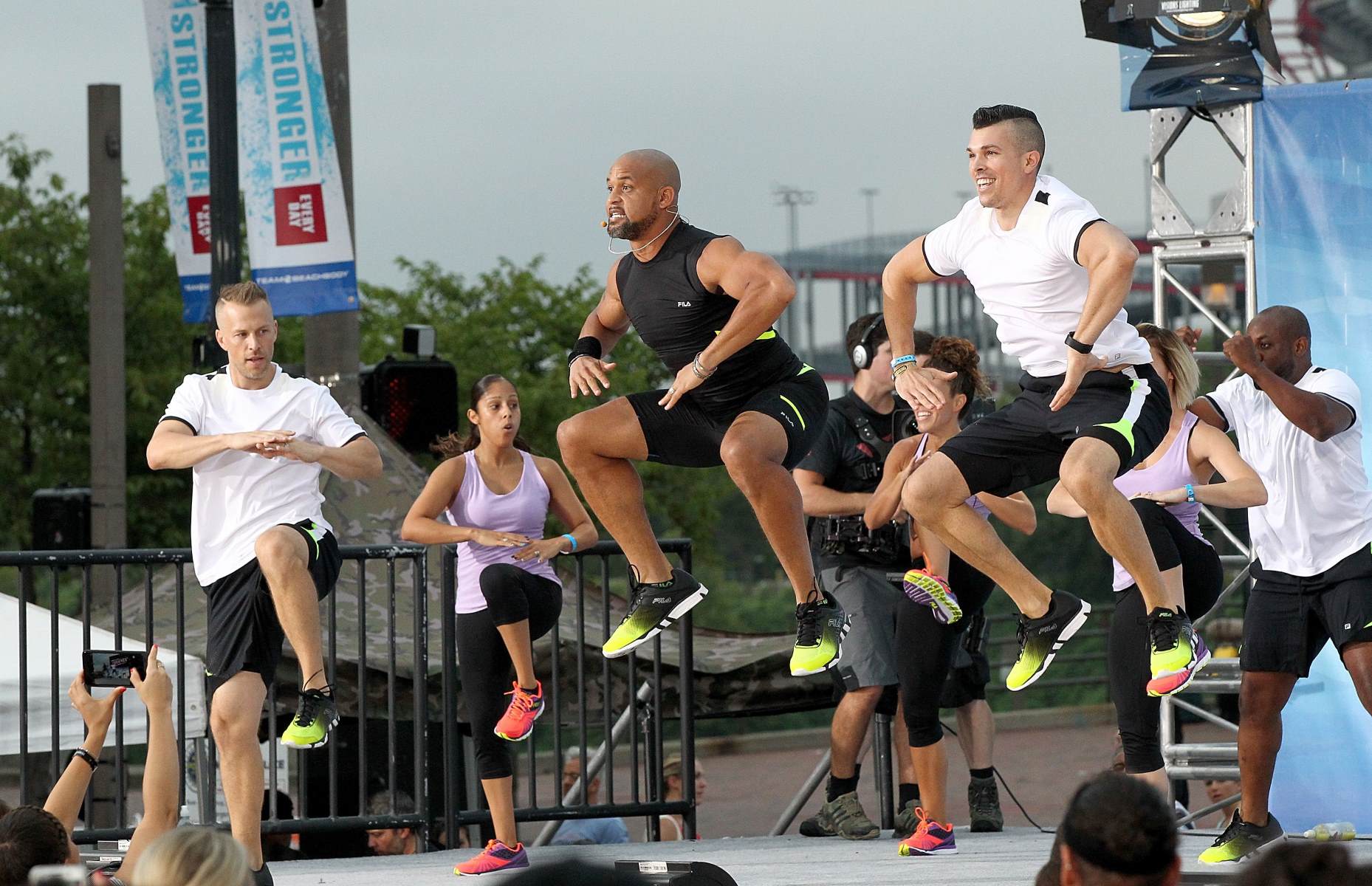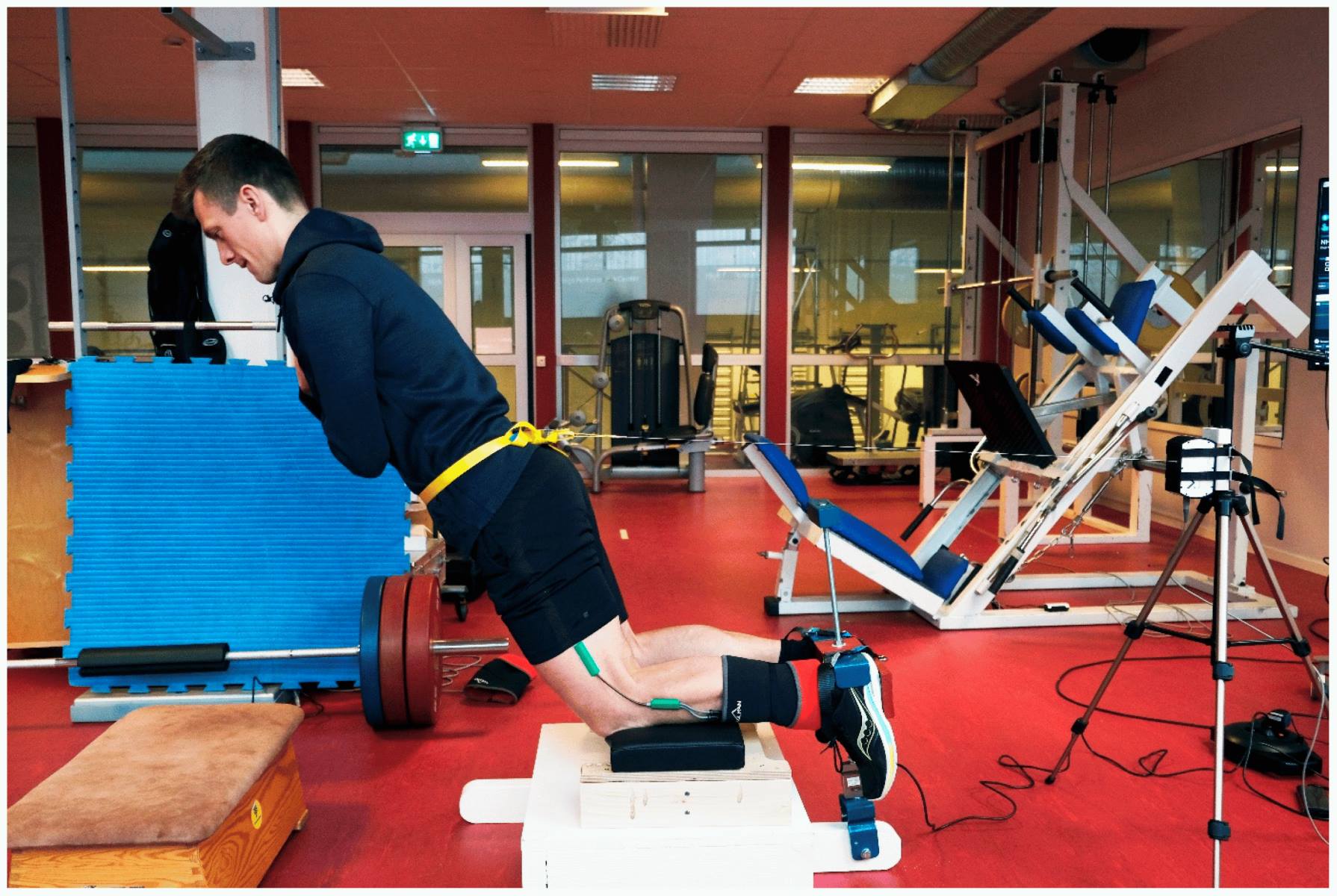

Featured
What Is A Plyometric Exercise
Modified: January 2, 2024
Discover the benefits of plyometric exercise and how it can improve your athletic performance. Get featured in our comprehensive guide on plyometric workouts.
Introduction
When it comes to reaching your fitness goals, incorporating a variety of exercises into your workout routine is essential. One type of exercise that has gained popularity in recent years is plyometric exercise. This form of training involves explosive movements that engage multiple muscle groups and increase power and speed.
Plyometric exercise, also known as jump training, is a unique training method that combines strength and speed to improve athletic performance. Originally developed for athletes in sports such as track and field, basketball, and volleyball, plyometric exercises have become popular among fitness enthusiasts of all levels.
What sets plyometric exercise apart from traditional strength training is its focus on rapid and explosive movements. By utilizing the stretch-reflex mechanism, which is the body’s natural response to stretch and contract muscles quickly, plyometric exercises help develop muscle power, speed, and agility.
In addition to improving athletic performance, plyometric exercise offers a range of benefits for individuals looking to enhance their fitness levels. These benefits include increased muscle strength and endurance, improved cardiovascular fitness, enhanced balance and coordination, and efficient calorie burning.
This article will delve deeper into the definition of plyometric exercise, explore its benefits, provide examples of common plyometric exercises, discuss how to perform them safely, and offer tips on integrating plyometric training into your fitness routine. It is important to note that while plyometric exercise can be highly effective, it should be approached with caution and proper technique to minimize the risk of injury.
Definition of Plyometric Exercise
Plyometric exercise, also known as plyometrics or jump training, is a high-intensity form of training that focuses on explosive movements. It involves rapidly stretching and contracting muscles to generate maximum force in a short period of time.
While traditional strength training exercises primarily focus on building muscle mass and strength, plyometric exercises aim to enhance power and speed. They utilize the stretch-reflex mechanism, which involves the quick lengthening of a muscle followed by an immediate contraction.
The stretch-reflex mechanism is a natural response of the body to protect muscles from overstretching. When a muscle is rapidly stretched, it stores elastic energy, which can then be used to produce a more forceful contraction. This allows for a greater output of power and speed during explosive movements.
During plyometric exercises, the muscles undergo a three-phase cycle: the eccentric phase (lengthening of the muscle), the amortization phase (transition phase between eccentric and concentric contractions), and the concentric phase (contracting of the muscle).
Examples of plyometric exercises include box jumps, depth jumps, medicine ball throws, and jump squats. These exercises typically involve jumping, hopping, bounding, and throwing movements, which engage multiple muscle groups and require quick and explosive actions.
Plyometric exercise can be a valuable addition to various fitness goals, including improving athletic performance, enhancing speed and power, and increasing vertical jump height. It can be particularly beneficial for athletes involved in sports that require explosive movements, such as basketball, soccer, and sprinting.
It is important to note that plyometric exercise is not recommended for beginners or individuals with certain medical conditions or injuries. Proper form, technique, and progression are crucial to ensuring safety and minimizing the risk of injury. It is always advisable to consult with a qualified fitness professional or trainer before incorporating plyometrics into your workout routine.
Benefits of Plyometric Exercise
Plyometric exercise offers a wide range of benefits for individuals looking to enhance their fitness levels and athletic performance. These benefits go beyond just building strength and can have a positive impact on various aspects of physical fitness. Let’s explore some of the key benefits of incorporating plyometric exercise into your workout routine:
- Improved Power and Speed: Plyometric exercises are designed to develop explosive power and speed. By training the muscles to quickly stretch and contract, plyometrics enhance muscle fiber recruitment and coordination, allowing you to generate more force in a shorter amount of time. This can translate to improved performance in sports and activities that require bursts of power and speed.
- Increased Muscle Strength and Endurance: The explosive nature of plyometric exercises engages multiple muscle groups simultaneously, leading to increased muscle strength and endurance. These exercises target both the fast-twitch and slow-twitch muscle fibers, helping to develop overall muscular strength and endurance.
- Enhanced Cardiovascular Fitness: Plyometric exercises elevate your heart rate and challenge your cardiovascular system, making them an effective way to improve cardiovascular fitness. Jumping, hopping, and bounding movements require a significant amount of energy, leading to increased calorie expenditure and improved cardiovascular endurance.
- Improved Balance and Coordination: Plyometric exercises demand a high level of coordination, balance, and body control. By consistently performing these exercises, you can enhance your proprioception and kinesthetic awareness, leading to better balance and coordination in both athletic activities and everyday movements.
- Efficient Calorie Burning: Plyometric exercises are highly intense and require explosive effort, resulting in a higher calorie burn compared to traditional strength training exercises. The combination of power, speed, and multi-muscle engagement leads to an elevated metabolic rate, allowing you to burn calories even after your workout is complete.
- Increased Bone Density: The high-impact nature of plyometric exercises stimulates bone growth and helps increase bone density. This can be particularly beneficial for individuals at risk of osteoporosis or those looking to maintain healthy bone density as they age.
It is worth noting that while plyometric exercises offer numerous benefits, they should be approached with caution and proper technique. Due to the high-force nature of these exercises, it is important to gradually progress, listen to your body, and prioritize safety to reduce the risk of injury.
Overall, incorporating plyometric exercises into your fitness routine can have a positive impact on your athletic performance, strength, endurance, cardiovascular fitness, and overall health and well-being. By adding variety to your workouts and challenging your body in new ways, you can reap the many benefits that plyometric exercise has to offer.
Common Plyometric Exercises
Plyometric exercises encompass a wide range of movements that involve explosive actions, focusing on power and speed. These exercises can be customized to cater to different fitness levels and goals. Here are some common plyometric exercises that you can incorporate into your workout routine:
- Box Jumps: This exercise involves jumping onto a sturdy box or platform from a standing position. It targets the lower body muscles, including the quadriceps, hamstrings, glutes, and calves. Start with a lower box height and gradually increase the height as your strength and confidence improve.
- Depth Jumps: Depth jumps involve stepping off a box or platform and immediately jumping vertically or horizontally upon landing. This exercise helps improve explosive power and reactive strength by stimulating the stretch-reflex mechanism. It is crucial to land softly and absorb the impact with proper form to minimize stress on the joints.
- Medicine Ball Throws: This exercise involves explosive tossing or slamming of a medicine ball, targeting the upper body muscles and core. You can perform various throws, such as overhead throws, rotational throws, and chest passes, to improve power and coordination in the upper body.
- Jump Squats: Jump squats combine a squatting motion with an explosive jump. Start in a squat position, and then explode upward, extending your legs and arms before landing softly back into the squat position. This exercise primarily targets the quadriceps, hamstrings, glutes, and calves, while also engaging the core muscles.
- Hurdle Jumps: Hurdle jumps involve jumping over hurdles set at various heights, encouraging both power and agility. This exercise targets the lower body muscles and enhances coordination and balance. It is important to start with lower hurdle heights and gradually increase the height as your strength and technique improve.
- Bounding: Bounding is a dynamic exercise that involves exaggerated strides and powerful jumps. It mimics the movements of running, but with longer and more forceful strides. Bounding helps develop power and explosiveness in the lower body, particularly targeting the glutes, hamstrings, and calf muscles.
Remember, when performing plyometric exercises, it is essential to maintain proper form and technique to maximize the benefits and minimize the risk of injury. Start with the exercises that match your current fitness level, gradually increase intensity and complexity over time, and always listen to your body’s signals.
It is advisable to seek guidance from a qualified fitness professional if you are new to plyometric exercises or have any pre-existing health conditions or injuries. They can ensure you are using correct form, provide appropriate modifications, and help you progress safely.
How to Perform Plyometric Exercises Safely
Plyometric exercises can be highly effective for improving power, speed, and overall athleticism. However, it is crucial to prioritize safety and proper technique to minimize the risk of injury. Here are some guidelines to follow when performing plyometric exercises:
- Warm-up: Before starting any plyometric exercise, it is essential to warm up properly. Engage in dynamic stretches and perform a light aerobic activity to increase blood flow and warm up the muscles. This will prepare your body for the explosive movements to come.
- Start with a Stable Surface: Begin by performing plyometric exercises on a stable and level surface. This will provide a solid foundation and help maintain proper form throughout the movements. Avoid uneven or slippery surfaces that could increase the risk of accidents or injuries.
- Focus on Landing Technique: Proper landing technique is crucial in plyometric exercises to minimize the impact on joints and prevent injury. Aim to land softly and quietly, with your knees slightly bent and aligned with your toes. Avoid landing with locked knees or collapsing inward.
- Progress Gradually: It is important to start with exercises that match your current fitness level and gradually progress in intensity and difficulty. Begin with lower impact variations and gradually increase the height, speed, or resistance as you gain strength and confidence. Never push yourself too far, too soon.
- Pay Attention to Form: Maintain proper form and technique throughout each exercise. Focus on engaging the correct muscles, relying on explosive power rather than momentum or swinging motions. Avoid excessive twisting or arching of the spine, as this can put unnecessary strain on the back.
- Allow Ample Rest and Recovery: Plyometric exercises are intense and put significant stress on the muscles and joints. Allow sufficient rest and recovery time between workouts to prevent overuse injuries. Incorporate rest days into your schedule and vary your training routine to avoid overloading specific muscle groups.
- Listen to Your Body: Pay close attention to any signs of pain, discomfort, or fatigue during plyometric exercises. If you experience sharp pain or excessive muscle soreness, it may indicate an injury or overtraining. Give your body the rest it needs and consult a healthcare professional if necessary.
- Modify for Fitness Level and Abilities: Plyometric exercises can be modified to suit your individual fitness level and abilities. If you are a beginner or have specific limitations, such as joint issues or lower fitness levels, consult with a fitness professional who can provide appropriate modifications or alternative exercises.
Remember, safety should always be a top priority when performing plyometric exercises. By following these guidelines and seeking proper guidance, you can enjoy the benefits of plyometrics while reducing the risk of injury.
Incorporating Plyometric Training into Your Fitness Routine
Plyometric training can be a valuable addition to your fitness routine, regardless of your fitness level or goals. Here are some tips on how to effectively incorporate plyometric exercises into your workout routine:
- Identify Your Fitness Goals: Determine why you want to incorporate plyometric training into your fitness routine. Are you looking to improve athletic performance, increase power and speed, or simply add variety to your workouts? Identifying your goals will help you choose the most appropriate plyometric exercises.
- Start Slowly: If you are new to plyometric exercises, start with a few exercises that match your current fitness level. Focus on mastering proper form and technique before increasing the intensity or difficulty. Gradually add more exercises and increase the challenge as your strength and confidence improve.
- Integrate Plyometrics with Other Training: Plyometric exercises can complement other training modalities, such as strength training or cardiovascular exercises. Incorporate plyometrics into your existing workouts by adding a few exercises at the beginning or end of your session, or dedicate a separate day for plyometric training.
- Create a Balanced Routine: Balance is key when incorporating plyometric training into your fitness routine. Avoid overdoing it with plyometrics and neglecting other important aspects of fitness, such as flexibility and muscular endurance. Aim for a well-rounded routine that includes a variety of exercises targeting different muscle groups and fitness components.
- Combine Plyometrics with Proper Recovery: Plyometric exercises are demanding on the muscles and joints. Allow sufficient rest and recovery time between plyometric sessions to avoid overtraining and reduce the risk of injury. This will also give your muscles time to repair and rebuild, leading to better performance in the long run.
- Progress and Challenge Yourself: As you become more comfortable with plyometric exercises, challenge yourself by increasing the intensity, duration, or difficulty of the movements. Incorporate advanced variations, use weighted implements, or adjust the speed and height of your jumps to continue pushing your limits and stimulating progress.
- Seek Professional Guidance: If you are unsure about how to incorporate plyometric training into your routine or have specific goals or considerations, it is beneficial to seek guidance from a qualified fitness professional. They can help design a program tailored to your needs, provide proper instruction, and ensure safe and effective progression.
Incorporating plyometric training can add excitement and variety to your workouts while helping you improve power, speed, and overall athleticism. Remember to listen to your body, respect your current fitness level, and prioritize proper form and technique. With persistence and consistency, you will reap the benefits of plyometric exercises and achieve your fitness goals.
Considerations and Precautions for Plyometric Exercise
While plyometric exercise can offer numerous benefits, it is crucial to approach it with caution and take certain considerations and precautions into account. Here are some important factors to keep in mind when incorporating plyometric exercises into your fitness routine:
- Physical Readiness: Plyometric exercises are high-impact and demanding on the muscles and joints. It is important to assess your current fitness level and physical readiness before engaging in plyometric training. If you are new to exercise or have any pre-existing health conditions or injuries, consult with a healthcare professional or qualified fitness trainer to determine if plyometrics are appropriate for you.
- Gradual Progression: Plyometric exercises should be approached with gradual progression. Start with lower intensity variations and gradually increase the complexity, intensity, and volume over time. Rushing into advanced plyometrics without building a solid foundation can lead to injury and hinder your progress.
- Proper Technique and Form: Correct technique and form are crucial in plyometric exercises to minimize the risk of injury and maximize benefits. Improper landing technique, excessive joint stress, and incorrect body alignment can lead to strains, sprains, or other injuries. Seek guidance from a qualified fitness professional to ensure you are performing plyometrics with proper form.
- Recovery and Rest: Plyometric exercises place a significant demand on the muscles and require ample recovery time. Allow for sufficient rest and recovery between plyometric sessions to prevent overuse injuries. Avoid performing plyometrics on consecutive days and make sure to include rest days in your overall training program.
- Individual Limitations: Each individual has unique physical capabilities and limitations. Be mindful of any personal restrictions, such as joint issues, previous injuries, or movement limitations, that may impact your ability to perform certain plyometric exercises. Modify exercises as necessary to work within your abilities and always prioritize safety.
- Appropriate Footwear and Surface: Wear proper athletic footwear that provides adequate support and cushioning when performing plyometric exercises. Additionally, choose a surface that is stable, level, and resilient to minimize the impact on your joints. Avoid performing plyometrics on hard or uneven surfaces to reduce the risk of injury.
- Listen to Your Body: Pay close attention to your body’s signals during plyometric exercises. If you experience persistent pain, discomfort, or excessive fatigue, it may be a sign that you need to modify the exercise or decrease the intensity. Pushing through pain or ignoring warning signs can lead to further injury.
- Warm-up and Cool-down: Prioritize a thorough warm-up before starting plyometric exercises to prepare your muscles, increase blood flow, and prevent injury. Incorporate dynamic stretches and gentle movements specific to the muscles you will be engaging. After your workout, cool down with static stretches to help reduce muscle soreness and promote flexibility.
Remember, safety should always be your top priority when incorporating plyometric exercises into your fitness routine. By considering these precautions and addressing any individual limitations or concerns, you can enjoy the benefits of plyometric training while minimizing the risk of injury.
Conclusion
Plyometric exercise is a dynamic and powerful training method that can enhance athletic performance, improve power and speed, and increase overall fitness levels. By incorporating explosive movements that engage multiple muscle groups, plyometric exercises offer numerous benefits such as increased muscle strength and endurance, improved cardiovascular fitness, enhanced balance and coordination, efficient calorie burning, and increased bone density.
However, it is vital to approach plyometric exercise with caution and take proper precautions to ensure safety and minimize the risk of injury. This includes gradually progressing in intensity and difficulty, maintaining proper form and technique, allowing for sufficient recovery time, and listening to your body’s signals.
When integrating plyometric exercises into your fitness routine, it is essential to identify your goals, start slowly and progress gradually, balance your routine with other types of training, and seek guidance from a qualified fitness professional if needed. By following these guidelines, you can effectively incorporate plyometric exercises into your routine and reap the many benefits they have to offer.
Remember, plyometric exercise is not suitable for everyone, especially those who are new to exercise or have certain health conditions or injuries. Consulting with a healthcare professional or fitness trainer can help determine if plyometrics are appropriate for you and provide guidance on modifications or alternatives, if needed.
Incorporating plyometrics can add excitement, challenge, and variety to your workouts. By combining these explosive movements with proper form, technique, and progression, you can optimize your training and reach new levels of athletic performance and physical fitness.









